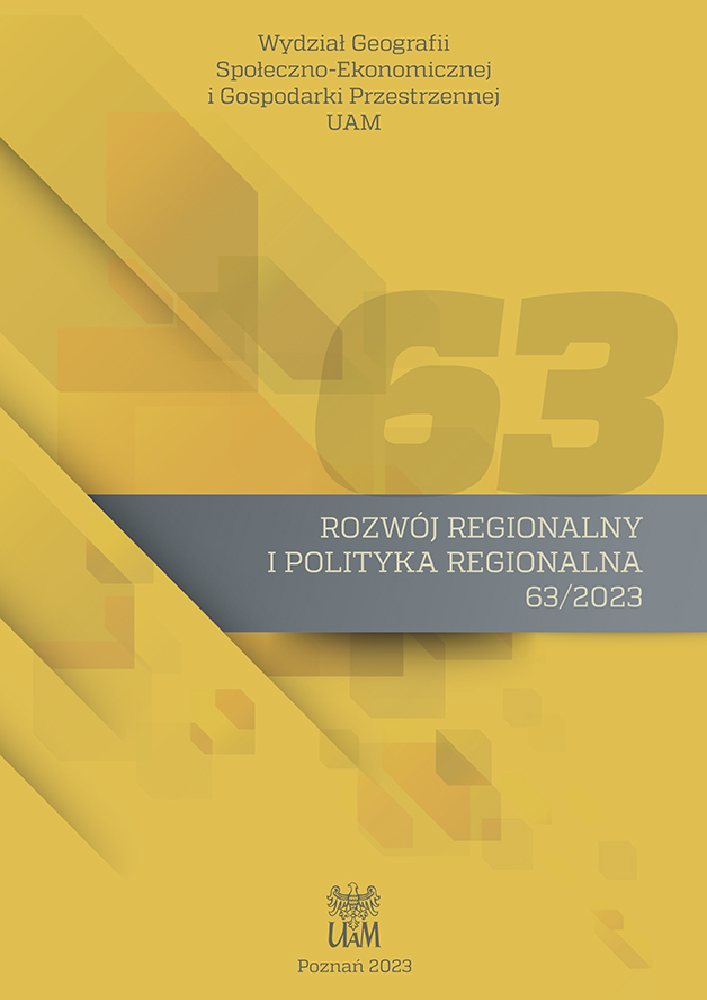Abstrakt
Pojęcie peryferyjności jest szeroko stosowane zarówno w debacie naukowej, jak i polityce regionalnej. Nie ma jednak konsensusu co do definicji tego pojęcia. Celem artykułu jest wypracowanie nowej definicji peryferyjności obejmującej to zjawisko w różnych skalach przestrzennych. Dokonano przeglądu literatury, w ramach którego zestawiano różne podejścia do peryferyjności (społeczne, ekonomiczne, sieciowe i geograficzne) oraz porównano peryferyjność ze zjawiskami pokrewnymi (marginalnością i wykluczeniem); opisano również zmianę rozumienia zjawiska peryferyjności w czasie. Finalnie wytypowano sześć kluczowych cech peryferyjności, które wyróżniają ją spośród zjawisk pokrewnych i w oparciu o nie stworzono definicję peryferyjności.
Bibliografia
Bajerski A. 2008. Problemy wydzielania peryferii społeczno-gospodarczych. Ruch Prawniczy, Ekonomiczny i Socjologiczny, 70(2): 159-167.
Barry F. 1996. Peripherality in Economic Geography and Modern Growth Theory: Evidence from Ireland’s Adjustment to Free Trade. The World Economy, 9(3): 345-365. DOI: https://doi.org/10.1111/j.1467-9701.1996.tb00682.x
Bernt M., Colini L. 2013. Exclusion, Marginalization and Peripheralization: Conceptual concerns in the study of urban inequalities. Working Paper (49), Leibniz-Institut für Regionalentwicklung und Strukturplanung (IRS), Erkner.
Blom T. 1998. Microperipherality in Metropolitan Areas. [W:] L. Andersson, T. Blom (red.), Sustainability and Development. On the Future of Small Society in a Dynamic Economy, s. 164-176.
Caldeira T.P. 2017. Peripheral urbanization: Autoconstruction, transversal logics, and politics in cities of the global south. Environment and Planning, D, 35(1): 3-20. DOI: https://doi.org/10.1177/0263775816658479
Chancel L., Piketty T., Saez E., Zucman G. i in. 2021. World Inequality Report 2022, World Inequality Lab (wir2022.wid.world). DOI: https://doi.org/10.4159/9780674276598
Copus A. 2001. From Core-periphery to Polycentric Development: Concepts of Spatial and Aspatial Peripherality. European Planning Studies, 9(4): 539-552. DOI: https://doi.org/10.1080/09654310120049899
Copus A., Mantino F., Noguera J.M. 2017. Inner Peripheries: an oxymoron or a real challenge for territorial cohesion? Italian Journal of Planning Practice, 7(1): 24-49.
Davies S., Michie R. 2011. Peripheral Regions: A Marginal Concern? EoRPA Paper, 11/6.
Dawkins C.J. 2003. Regional Development Theory: Conceptual Foundations, Classic Works, and Recent Developments. Journal of Planning Literature, 18(2): 131-172. DOI: https://doi.org/10.1177/0885412203254706
de Falco S., Angelidou M., Addie J.-P.D. 2019. From the “smart city” to the “smart metropolis”? Building resilience in the urban periphery. European Urban and Regional Studies, 26(2): 205-223. DOI: https://doi.org/10.1177/0969776418783813
Dietz R.D. 2002. The estimation of neighborhood effects in the social sciences: An interdisciplinary approach. Social Science Research, 31: 539-575. DOI: https://doi.org/10.1016/S0049-089X(02)00005-4
Demaniuk W., Szymańska E. 2016. Regiony peryferyjne i czynniki ich dynamiki w teoriach rozwoju regionalnego. Społeczeństwo i Ekonomia, 2(6): 103-110. DOI: https://doi.org/10.15611/sie.2016.2.07
Déry S., Leimgruber W., Zsilincsar W. 2012. Understanding Marginality: Recent Insights from a Geographical Perspective. Hrvatski Geografski Glasnik, 74/1: 5-18 DOI: https://doi.org/10.21861/HGG.2012.74.01.01
Domański R. 1993. Gospodarka przestrzenna. Wydawnictwo Naukowe PWN, Warszawa.
EPSON 2020. PROFECY - Proceses, Features and Cycles of Inner Peripheries in Europe Final Report.
Gulczyński M. 2021. Przemilczane nierówności o problemach mężczyzn w Polsce. Raport Klubu Jagiellońskiego, 05 (https://klubjagiellonski.pl/wp-content/uploads/2021/09/przemilczane-nierownosci-1.pdf).
Gurung S.G., Kollmair M. 2007. Marginality: Concepts and their Limitations. NCCR North-South Dialogue, 12. Bern, Switzerland
Herrschel T. 2011. Regional Development, Peripheralization and Marginalization - and the role of Governance. [W:] T. Herrschel, P. Tallberg (red.), The Role of Regions? Networks, Scale Territory. Sveriges Kommuner och Landsting.
Grzeszczak J. 1999. Bieguny wzrostu a formy przestrzeni spolaryzowanej. Prace Geograficzne, 173. IGIZP PAN, Wrocław.
Jałowiecki B. 1996. Przestrzeń historyczna, regionalizm, regionalizacja. [W:] B. Jałowiecki (red.), Oblicza polskich regionów. Uniwersytet Warszawski, Europejski Instytut Rozwoju Regionalnego i Lokalnego, Warszawa, s. 19-88.
Korenik S., Pięta M., Soczewka K., Kostrzewa-Tomczak T. 1985. Myrdalowska zasada przyczynowości okrężnej a problem rozwoju gospodarczego krajów słabo rozwiniętych. Acta Universitatis Lodziensis, Folia Oeconomica, 56: 57-74.
Kühn M. 2014. Peripheralization: Theoretical Concepts Explaining Socio-Spatial Inequalitie. European Planning Studies, 23(2): 367-378. DOI: https://doi.org/10.1080/09654313.2013.862518
Kühn M., Bernt M. 2013. Peripheralization and Power - Theoretical Debates. [W:] A. Fisher-Tahir, M. Neumann (red.), Peripheralization The Making of Spatial Dependencies and Social Injustice, s. 302-317. DOI: https://doi.org/10.1007/978-3-531-19018-1_15
Levitas N., Pantazis Ch., Fahmy E., Gordon D., Lloyd E., Patsios D. 2007. The multi-dimensional analysis of social exclusion Department of Sociology and School for Social Policy. Townsend Centre for the International Study of Poverty and Bristol Institute for Public Affairs University of Bristol.
Mehretu A., Pigozzi B.W., Sommers L.M. 2000. Concepts in social and spatial marginality. Geografiska Annaler, 82 B (2): 89-101. DOI: https://doi.org/10.1111/j.0435-3684.2000.00076.x
Miszczuk A. 2013. Uwarunkowania peryferyjności regionu przygranicznego. Norbertinum, Lublin.
Myrdal G. 1957. Economic theory and underdeveloped regions. G. Duckowrth, London.
Proniewski M. 2014. Polityka rozwoju regionów peryferyjnych. Optimum, Studia Ekonomiczne, 6(72): 79-90. DOI: https://doi.org/10.15290/ose.2014.06.72.06
Puga D. 1999. The rise and fall of regional inequalities. European Economic Review, 43: 303-334. DOI: https://doi.org/10.1016/S0014-2921(98)00061-0
Torre A., Rallet A. 2005. Proximity and Localization. Regional Studies, 39(1): 47-59. DOI: https://doi.org/10.1080/0034340052000320842
Licencja
Prawa autorskie (c) 2023 Mikołaj Grosel

Utwór dostępny jest na licencji Creative Commons Uznanie autorstwa 4.0 Międzynarodowe.

